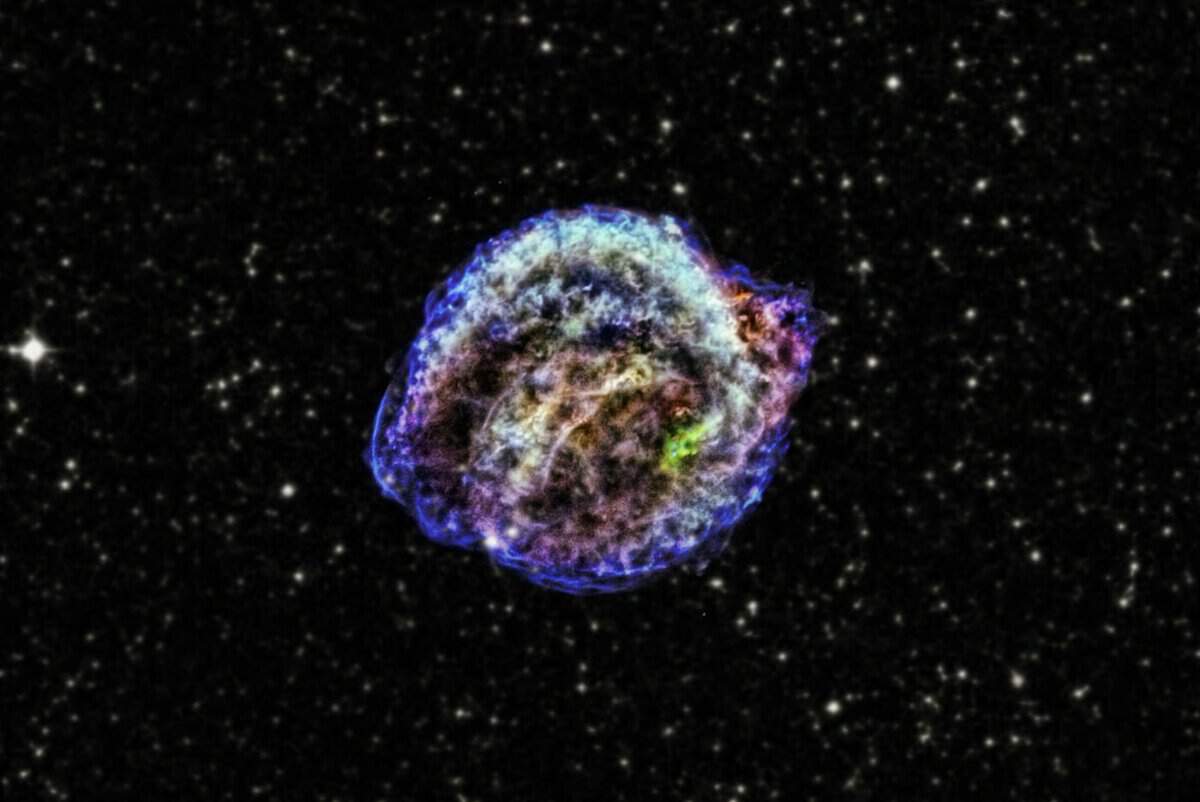Approximately 5000 years ago, the night sky was illuminated by a dazzling disk, shining as brightly as our own Sun. The inhabitants of a nearby city were overcome with fear and rushed to the temples seeking refuge. The priests, using their divination skills, predicted impending misfortune and divine retribution that would befall the sinners unless they made generous offerings to appease the gods. The desperate townspeople flocked to the temple, bringing valuable gifts in the hope of averting disaster. The priests fervently prayed, and their prayers were answered as the benevolent deity averted the calamity. Gradually, the second sun began to lose its brilliance, and after a year, it vanished completely from the celestial realm. Thanks to the deciphering of cuneiform tablets from the ancient Sumerian civilization, modern scientists have been able to unravel the mysteries surrounding this second sun.
Hundreds of years later, according to the records of Chinese and Arab astronomers dating back to 1054, there are also mentions of a bright star appearing in the sky. This celestial body’s luminosity astounded observers as its light shone both day and night for a duration of three weeks.
However, the ancient individuals who witnessed this dazzling glow could not fathom that what they were witnessing was not the birth of a new star, but rather the demise of an old, antiquated celestial entity. Within this dying star, nuclear reactions had ceased, and due to the compelling force of its own gravity, a colossal explosion occurred, visible to those located tens of light years away. For neighboring systems, this event constituted a catastrophic calamity, bringing about destruction within a radius of 50 light years. The magnitude of the explosion amounted to an astonishing 1.046 joules, while the temperature of the supernovae soared to a mind-boggling 100 billion degrees Celsius!
The distinction between a nova and a supernova
In ancient times, observers lacked the understanding that a luminous celestial entity in the sky could be the outcome of distinct processes. Their sense of wonder and the absence of specialized equipment hindered the recognition of this distinction. It was not until the invention of telescopes that these disparities were revealed. It was discovered that what we refer to as a nova or supernova is not the actual star, but rather its explosive event.
Despite the similar names, the astronomical phenomena associated with these events are characterized by notable differences.
Throughout the existence of a blazing celestial body, there exists an uncompromising battle between opposing forces. The star’s gravitational pull relentlessly attempts to compress the central stellar mass, striving to transform the immense fiery sphere into a mere soccer ball. Simultaneously, thermonuclear reactions surge within the depths of the stellar mass and on its surface, endeavoring to rip the luminary apart into minuscule fragments.
Within the core of the youthful star lies an abundance of hydrogen reserves, and due to the continuous fusion reactions that convert hydrogen atoms into helium, a state of relative equilibrium is achieved between the forces of gravity and thermonuclear reactions.
However, all things eventually come to an end, and after a couple or three billion years, the hydrogen supplies are depleted and the once active star begins to age. The core transforms into a scorching mass of helium, with hydrogen burning away at its outer edges. In its final convulsions, the remaining reserves of hydrogen are consumed, leaving the celestial luminary powerless against its own gravitational pull.
The star gradually collapses, shrinking hundreds of thousands of times in size. Simultaneously, nearly all of its stellar energy is unleashed. The dying star’s last breath is a brilliant explosion, which astronomers and observers document in historical records and scholarly works as the emergence of a supernova..
The tremendous release of energy surpasses the brightness of an entire galaxy, and the cosmic wind disperses the rich elements across the vastness of interstellar space. New planets are born in distant star systems from the remnants of the star, hundreds of light years away from the site of the cosmic catastrophe.
There are different types of dead stars, depending on how they meet their end:
When a supernova detonates, the star perishes permanently, transforming into either a black hole or a neutron star.

The burst of a new star – is equally impressive (as the brightness of an ordinary celestial body increases from 50,000 to 100,000 times), but more frequent. Typically, it occurs in a binary star system, where one star is much older and is either on the main sequence or has transitioned into the red giant stage and has already filled its Roche lobe, while the second star is a white dwarf. As a result of the close interaction, gas containing up to 90% hydrogen flows from the giant star to the white dwarf through the vicinity of the Lagrangian point L1.
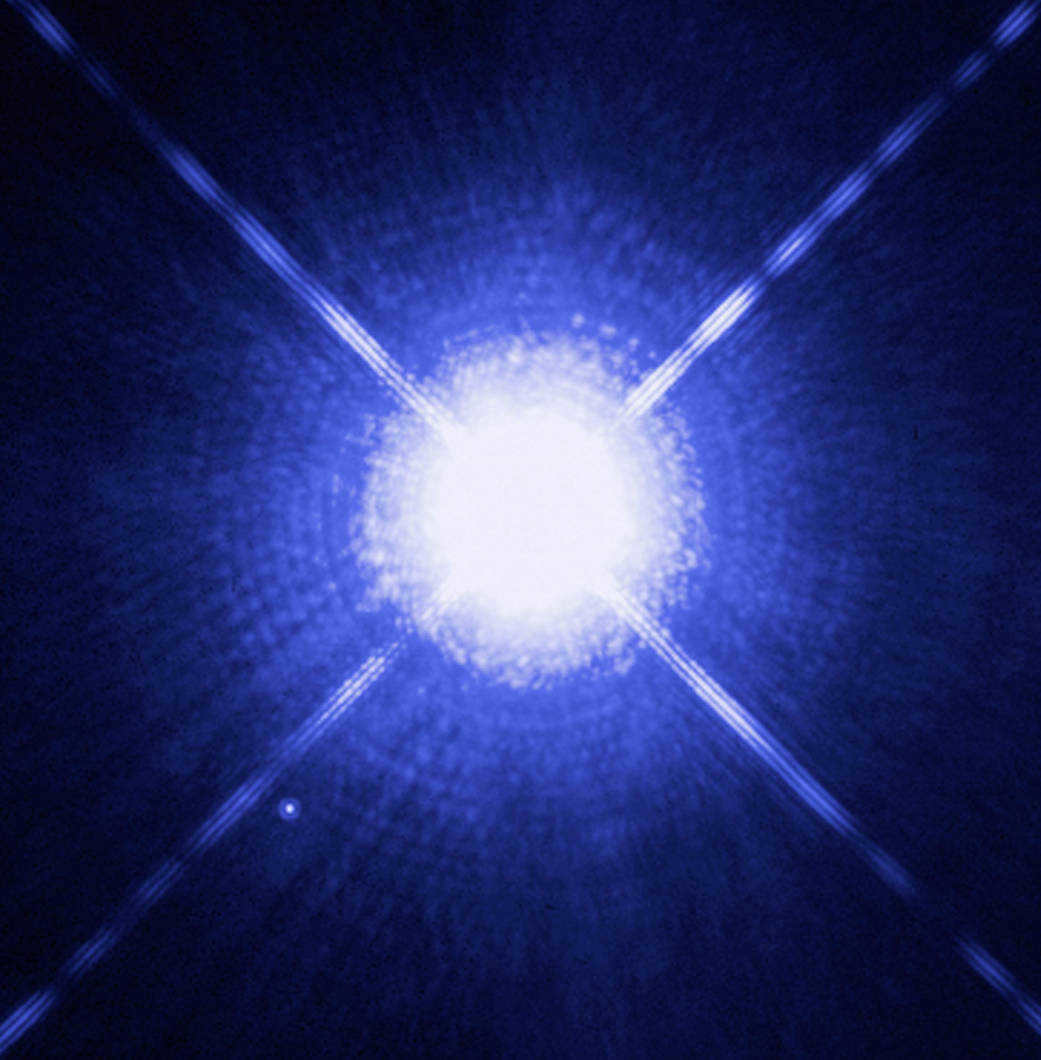
The material generated by the dwarf star forms a disk of matter around the smaller star. The rate at which this material accumulates on the white dwarf is constant. By knowing the characteristics of the companion star and the mass ratio of the binary system’s component stars, it is possible to calculate this rate.
However, greed has never led anyone to anything good. When there is an excess of hydrogen around the white dwarf, an explosion of tremendous power occurs. If the mass of the white dwarf reaches 1.4 times that of the Sun, an irreversible supernova explosion takes place.
To summarize, a new star is born through an explosion caused by thermonuclear reactions on the surface of a small, dense star. A supernova explosion results in the core of a massive star, many times larger than the Sun, becoming compressed, leading to the complete destruction of the star’s surrounding layers.
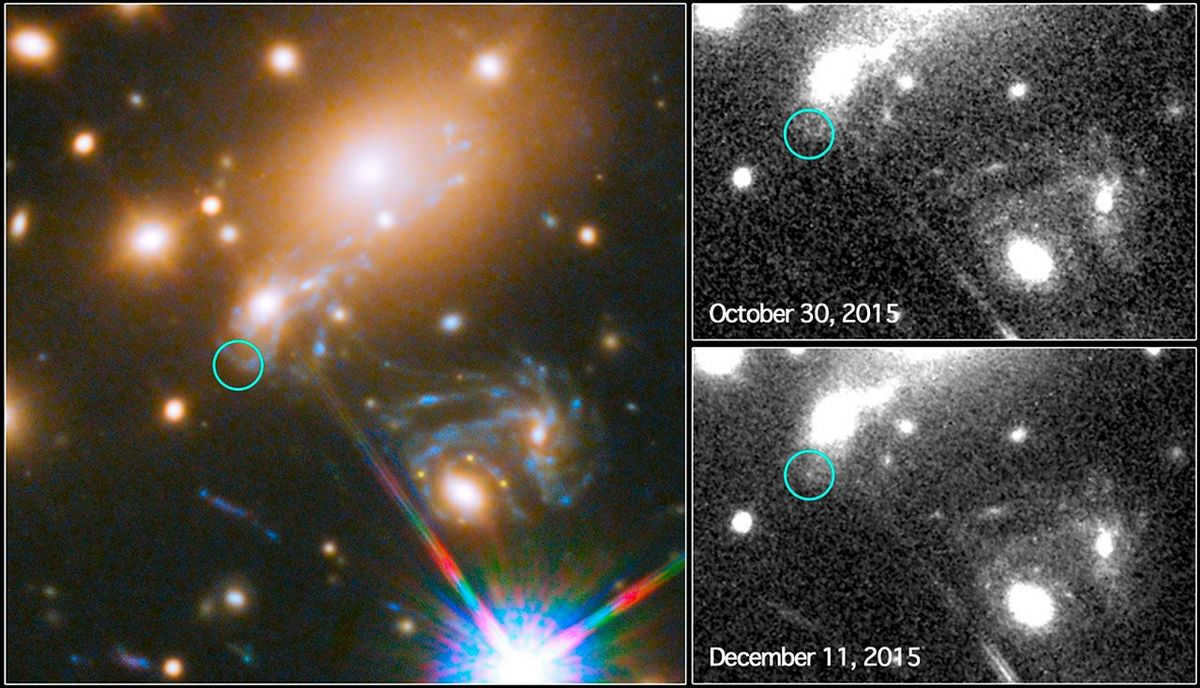
Astronomers are actively searching for supernovae
Let’s begin by discussing the process of supernova formation. When a sufficient amount of gas accumulates in a specific location, its mass starts exerting a gravitational force that is concentrated at the center of the gas cloud. Once the pressure surpasses a certain threshold, fusion reactions of hydrogen atoms at the core of the sphere begin, leading to the ignition of the gas and its transformation into a star. However, throughout the star’s lifespan and its combustion process, there is a constant battle between the outward pressure from the temperature reaction and the inward gravitational compression.
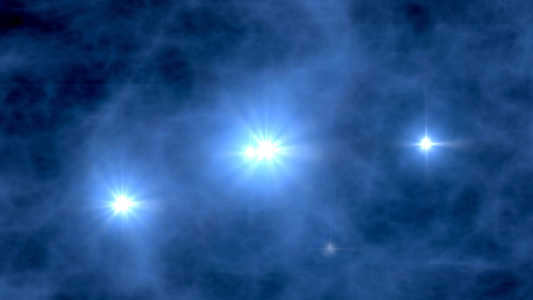
A visual representation of the initial stars
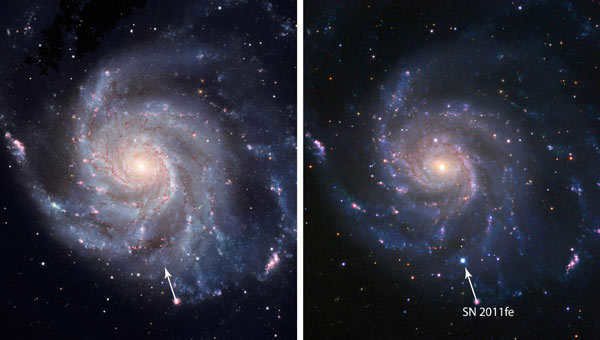
After billions of years of burning, the outward pressure decreases while the force of gravity remains relatively constant. As a result, smaller and medium-sized stars begin to cool down and gravity starts to dominate. However, since these stars are not very large, gravity only serves to hold the matter together. This cooled-down star is known as a white dwarf. The Chandrasekar limit is the mass threshold required for a supernova to occur, which is roughly equivalent to 1.4 solar masses. If the star is smaller than this limit, it will simply fade away.
Supernovae are incredibly luminous and can easily be distinguished even among galaxies.
Alternatively, if the central part of the white dwarf is predominantly made up of neon, its central region will undergo a collapse, resulting in an eventual explosion. However, following this event, a neutron star will be left behind. This scenario is commonly observed in binary systems, where one star nears the Chandrasekar limit and accretes material from its companion. Due to the inability of astronomers to directly observe a star’s core, it remains uncertain which of these evolutionary paths it will follow.
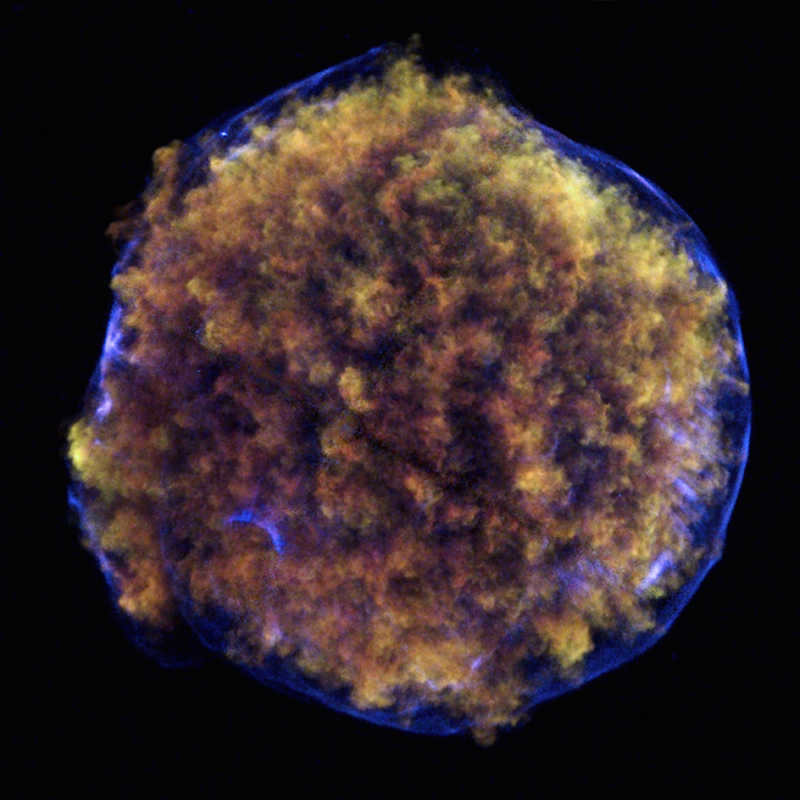
The remnants of Tycho’s supernova
Stars with a mass greater than 1.4 times that of the Sun follow a different life cycle. The red giant gradually consumes its fuel, and its gravitational force becomes strong enough to cause the core to collapse and trigger a supernova explosion. Stars with a mass between 1.4 and 3 times that of the Sun collapse into neutron stars.
Heavier stars also undergo collapse, but they continue collapsing until they become black holes. This is a relatively rare phenomenon. While there are numerous black holes in the universe, their numbers are significantly lower compared to other types of stellar remnants.
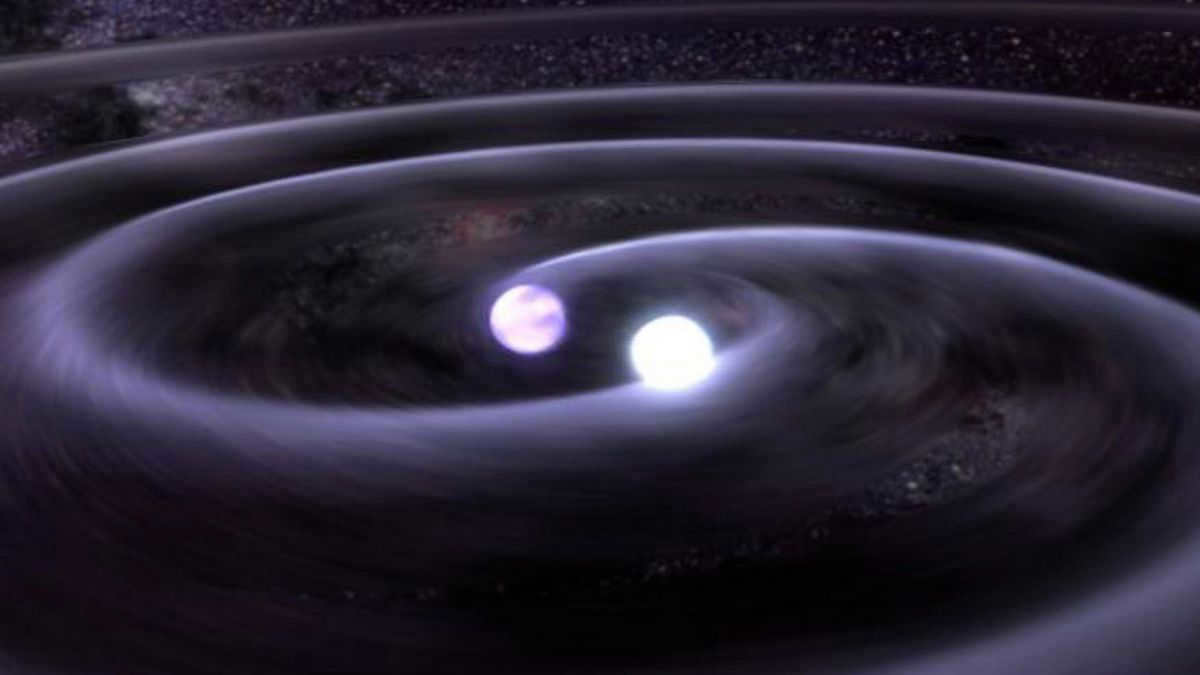
An artist’s perspective on a binary system
Supernovae can manifest in various ways as well. For instance, while the majority of white dwarfs accumulate mass at a slow pace, certain stars can rapidly amass mass (e.g., through collisions with other stars) and exceed the Chandrasekar limit so swiftly that they do not have sufficient time to initiate the collapsing process.
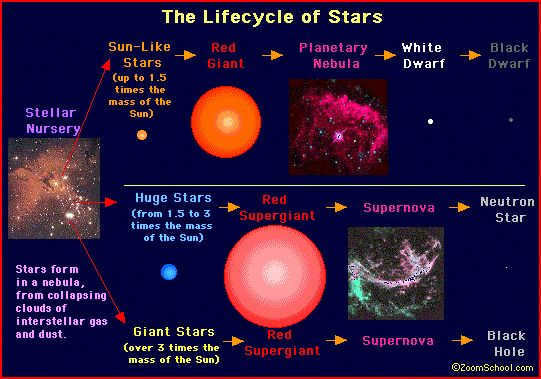
However, the main idea is that supernovae are not only fascinating and valuable phenomena. When it comes to producing elements heavier than carbon and neon, regular stars simply can’t compete. Only dying stars, known as supernovae, have the power to create such elements.
Essentially, everything we are dealing with today was at some point expelled by a star during the final moments of its existence. The Earth itself is a collection of debris that was ejected by a supernova. This includes comets, asteroids, and anything else that is made up of heavier substances. Even we humans, who are composed of matter taken from the Earth, are essentially made from the remnants of a supernova.
A star is essentially a massive ball of gas that is in a state of balance due to the forces of gravity and internal pressure. Deep within any star, there are (or once were) reactions of thermonuclear fusion.
At first, the star begins as a frigid interstellar gas cloud, but as gravitational forces take hold, it slowly condenses and forms into a spherical shape. As the compression occurs, the gravitational energy transforms into heat, causing the object’s temperature to rise. However, once the temperature reaches 15-20 million Kelvin (15-20 thousand degrees Celsius), the compression halts and triggers thermonuclear reactions, effectively transforming the object into a star.
What do stars look like?
Stars come in a variety of forms, and I’ve chosen a few that caught my interest.
Neutron stars are particularly fascinating. Despite their small size, which is even smaller than Earth, they possess an incredibly high density. This is due to a process called neutronization, where the intense gravitational forces cause atomic nuclei to absorb electrons, resulting in the merging of protons and electrons to form neutrons. Additionally, neutron stars are known for their powerful magnetic fields.
Another captivating type of star is the double star. These are two stars that are gravitationally bound to each other and orbit around a common center of mass. It’s actually quite common for stars in our galaxy to exist as double star systems.
In reality, supernovae are celestial bodies that undergo a massive eruption, causing their luminosity to drastically intensify before gradually diminishing. It’s fascinating to consider that their brightness can surge by as much as 10 to 20 magnitudes.
A supernova outburst exemplifies the occurrence in which stellar brightness experiences a sudden surge followed by a gradual decline.
Interestingly, this event takes place during the ultimate phase of evolution for certain objects, resulting in a cataclysmic release of an immense amount of energy into the interstellar expanse.
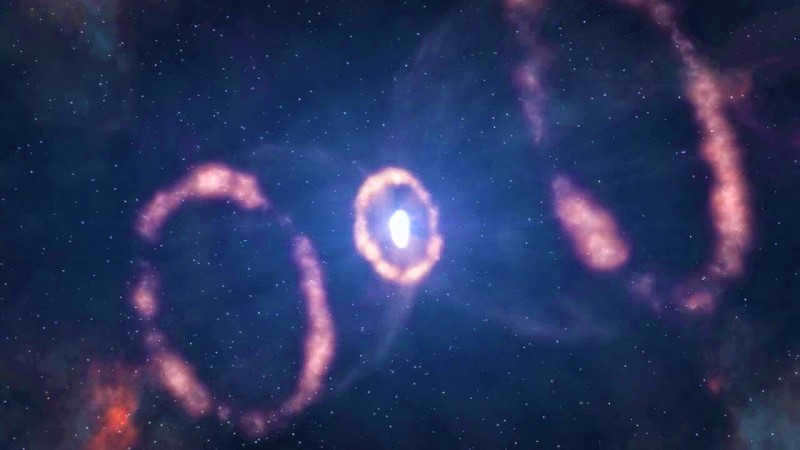
SN 1987A Type II-P supernova
The Creation of New Supernovae Stars
Scientists believe that the interior of a star experiences a rapid increase in the mass of matter involved in thermonuclear reactions. In simpler terms, an explosion occurs. However, this phenomenon occurs in multiple star systems. For example, a star in the main sequence, with its balanced processes, is unable to trigger a flash.
The explosion of a supernova star has a unique nature compared to other flares.
Interestingly, their spectra do not show any hydrogen lines, indicating a scarcity of hydrogen in these stellar bodies before the outburst. However, they do produce a significant amount of matter, primarily composed of carbon, oxygen, and other heavy elements.
Furthermore, spectral analysis reveals a shift in the silicon line, suggesting nuclear reactions taking place during the ejection.
Therefore, it is hypothesized that the supernova was a dwarf star in the past, most likely a white dwarf composed of carbon and oxygen.
Categories of supernovae
It is important to mention that they are designated with the prefix “SN” and the year of their discovery, followed by letters indicating the sequential number of the object within that year. For instance, they are initially named from A to Z, and then progress to aa, ab, ac, and so on.
Naturally, members of the same category can never be completely identical. They have their differences, particularly in terms of their luminosity and the manner in which they are formed.
Therefore, two categories are distinguished:
Type I: Occurring within a binary system (consisting of a white dwarf and a more massive companion), matter is transferred to the dwarf component. This leads to an explosion, followed by compression and the formation of a neutron star.
It’s worth noting that their spectrum does not contain any hydrogen. Based on this characteristic, they can be divided into subtypes Ia, Ib, and Ic.
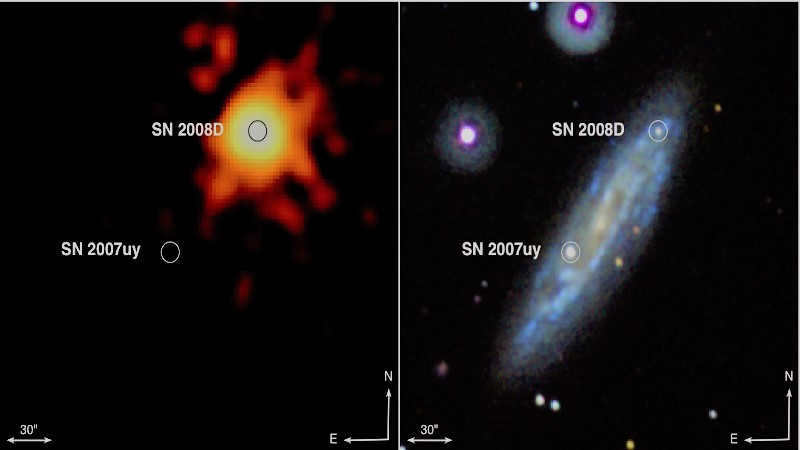
The phenomenon known as Type Ib supernova SN 2008D is depicted in the image above.
Furthermore, the period of peak brightness lasts for approximately two or three days, during which a high level of luminosity is observed.
Type II supernovae occur when a massive giant or supergiant star explodes and its core collapses, resulting in the rapid ejection of its elements in various directions.
Interestingly, hydrogen lines are detected in the spectrum of such objects. Additionally, subtypes within the Type II category include II-L, II-P, IIb, and IIn.
Moreover, Type II supernovae are characterized by a more prolonged increase in brightness, although the overall luminosity is lower and the decrease occurs at a faster rate compared to Type I supernovae.
It is intriguing that these occurrences are only detected after the explosion. It is only when the energy they release, known as radiation, reaches the Earth’s atmosphere that they become observable.
In fact, this is why objects such as supernovae have remained enigmatic and unknowable for a considerable period of time.
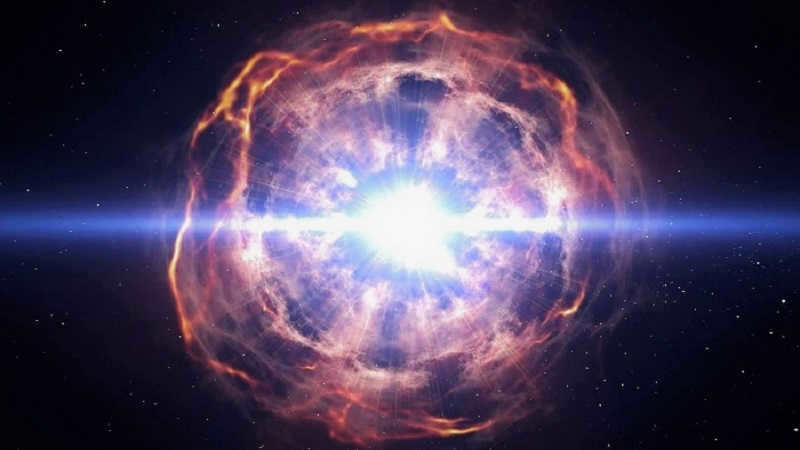
The emergence of a supernova
What is left in the aftermath of a supernova eruption
After the explosion, what remains is a composition of gas and dust, as well as remnants of substances that were involved in the existence of the celestial body. This preserved material is referred to as the supernova remnant.
To put it differently, the supernova remnant is the nebula that is formed following the explosion and transformation of a star into a supernova. As the shell ruptures, its particles disperse, creating a shockwave. This shockwave then rapidly expands, forming a region of gas and dust. This region contains, among other things, stellar matter and matter from outer space that have been brought together by this wave.
Certainly, the remains are also observed, like the explosion itself, after a certain period of time. Sometimes, this can take hundreds of years.
Supernova stars and their notable examples
We can identify several of the most renowned representatives: SN 1572 (also known as Tycho Brahe’s star, as he provided its description), SN 1604, SN 1987A, and SN 1993J.
For instance, among these types of celestial bodies, it is worth noting the most brilliant one of the past century, SN 1987A, while the front-runner of the current century remains SN 2006gy.
By the way, the famous Crab Nebula is a remnant of SN1054.
What is the significant role of supernovae?
Supernovae play a crucial role in the chemical evolution of galaxies and the entire Universe.
It is important to acknowledge that nuclear reactions occur inside the celestial body throughout its lifespan, which spans thousands of years. During this time, fusion byproducts accumulate within the star.
Presently, we understand that when a stellar entity undergoes a cataclysmic explosion, matter and energy are released into the vastness of space. In essence, everything that has been accumulated disintegrates around it. Consequently, the region becomes enriched with chemical elements, thereby driving the evolution of our Universe.
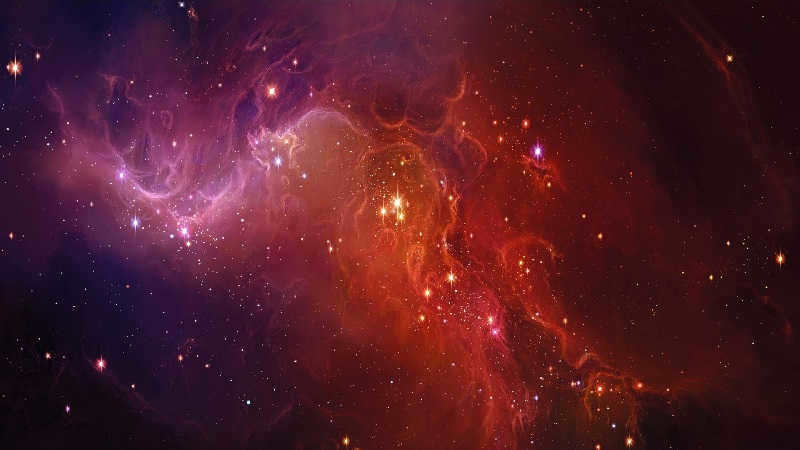
Ultimately, the maximum luminosity of a supernova can serve as a standardized measure. This means it can be used to calculate distances between celestial objects. Furthermore, with the aid of state-of-the-art telescopes, it is now possible to observe supernovae in nearby galaxies. This represents a significant breakthrough in the exploration and study of the universe.
When a massive star reaches the end of its life, it undergoes a supernova explosion. During this process, it becomes exceptionally bright in a relatively short amount of time. However, the exact cause of this phenomenon has long remained a mystery. Since scientists are unable to peer inside a star, the only way to gain insight is through the use of supercomputers to model the explosion.
The start is derived from the ultimate stage of a star’s life cycle: once all the hydrogen has been depleted, it commences shrinking. At its core, an iron nucleus is created, wherein the material is obliterated by the force of gravity. Consequently, a neutron star is formed within the core, possessing the dimensions of a metropolis, yet containing a greater mass than that of the Sun.
Scientists theorize that the contracting material collides with the core, generating an immense shockwave that reverberates outward. However, this shockwave encounters additional contracting material along its trajectory and becomes ensnared within the core, incapable of escaping.
Article on the same topic

The presence of small irregularities on the surface of matter can quickly grow into large oscillations. These irregularities can be observed as the matter moves on a neutron star, resembling the behavior of a liquid. Additionally, the surrounding matter is heated by neutrinos, particles that are produced within the neutron star, resulting in an eruption. The combined effect of intense neutrino heating and the pressure exerted by the moving matter causes the shock wave to dislodge. Once dislodged, the wave accelerates, leading to the explosion of the star. While the actual explosion occurs in less than half a second, it may take up to a day for the shock wave to reach the surface of the star.
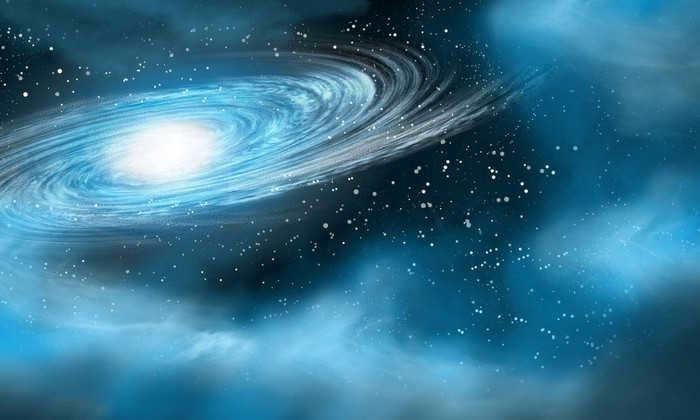
By comprehending this procedure, astronomers will be able to unravel other enigmas of the cosmos. For instance, they will be able to determine the origins of the atoms of chemical elements that are crucial for the creation of new stars and planets in such explosions. Researchers posit that the most recent supernova in our galaxy occurred around 1870. However, typically these occurrences happen twice in a century.
In the past 40,000 years, American scientists have discovered that four supernovae have erupted in close proximity to Earth, which could potentially impact the climate of our planet. Here is an elucidation of the implications of this finding.
Read “Hitech” in
Which supernovae have occurred in close proximity to Earth?
According to a recent study, it is possible for any star to potentially explode near our planet. However, there are four specific stars that are considered the most likely candidates.
One of these explosions, from a former star located in the Vela constellation, took place approximately 815 light-years away from Earth around 13,000 years ago. As a result of this event, the amount of carbon-14 on Earth increased by a significant 3%. This suggests that nearby supernovae explosions do indeed have an impact on our planet.
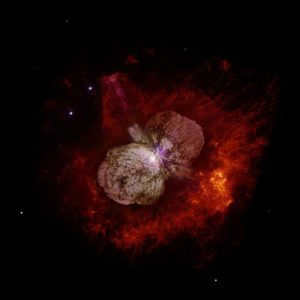
What is the cause of stars exploding?
Stars only explode, or undergo supernovas, if they have a mass exceeding 20 times that of the sun. When this occurs, the core of the star collapses due to a depletion of fuel needed to sustain thermonuclear reactions.
Since the early 1990s, incredibly powerful star explosions have been observed, with each explosion surpassing the power of a typical supernova by a factor of approximately 10. The energy released in these explosions exceeds 10^45 joules, and many of them are accompanied by long gamma-ray bursts.
The term “hypernova” is now used to describe the explosions of stars with masses of 100-150 solar masses or greater.
Hypernovae are a potential danger to Earth because of the gamma-ray burst they produce, but fortunately, there are no such hazardous stars in close proximity to our solar system. As per certain accounts, approximately 440 million years ago, a hypernova exploded near our solar system, and the resulting gamma ray burst was incredibly intense, leading to the Ordovician-Silurian extinction event, which resulted in the disappearance of over 60% of marine invertebrate species.
What is the impact of supernova explosions on our planet?
Supernova explosions that occur in close proximity to our planet are known as near-Earth supernovae. These powerful bursts of energy have a significant effect on Earth’s biosphere.
According to statistical calculations, a supernova explosion happens within 10 parsecs of Earth approximately every 240 million years. The main consequence of a supernova on an Earth-like planet is the emission of gamma rays.
For Earth specifically, gamma rays have the potential to initiate a chemical reaction in the upper atmosphere, leading to the oxidation of molecular nitrogen and the depletion of the ozone layer.
Scientists have determined that for the ozone layer to be reduced by half, a Type II supernova would need to occur within 8 parsecs (26 light-years) of Earth. This estimation is based on atmospheric modeling and the measured radiation flux from SN 1987A, which was a Type II supernova that occurred in 1987 in the Large Magellanic Cloud.
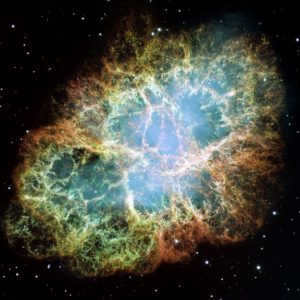
Research on the breakdown products of radioactive isotopes with short lifespans indicates that the elemental makeup of our solar system was greatly impacted by a supernova that occurred approximately 4.5 billion years ago, and it’s even possible that this event played a role in the formation of our planetary system. The creation of heavy elements within supernovae throughout the universe’s development has enabled the existence of life on Earth.
Is it possible for supernova explosions to impact the climate?
A recent study conducted by scientists at the University of Colorado in Boulder, USA, suggests that supernova explosions do indeed have an influence on Earth’s climate.
The researchers examined wood samples to determine the presence of carbon-14, an isotope that is produced when cosmic rays interact with the Earth’s atmosphere.
Typically, tree rings accumulate a consistent amount of carbon isotopes, but the experts discovered several peaks where the concentration of carbon-14 dramatically increased. Some scientists speculated that these peaks might be linked to solar flares.
Please note that a small amount of this isotope is always present in the atmosphere, which is formed due to the impact of cosmic rays. When living organisms incorporate it into their tissues, the concentration gradually decreases only after death, while carbon-14 decay continues. This process serves as the foundation for radiocarbon dating.
In line with this, scientists have associated the spikes in carbon-14 concentration with supernovae and have investigated whether there have been any star explosions near Earth in the past 40,000 years. Experts have identified them by examining the nebulae left behind after the explosions.
As a consequence, a total of eight supernovae were identified that met the specified requirements. Among them, four proved to be the most suitable contenders. To illustrate, one of the bursts occurred approximately 13,000 years ago at a distance of 815 light years away from our planet. Consequently, there was a 3% increase in the concentration of matter.
Further reading:
The cosmos is filled with numerous captivating occurrences, leading to the emergence of new stars, the disappearance of old ones, and the formation of black holes. One of the most astonishing and enigmatic phenomena is gravitational collapse, which marks the culmination of stellar evolution.
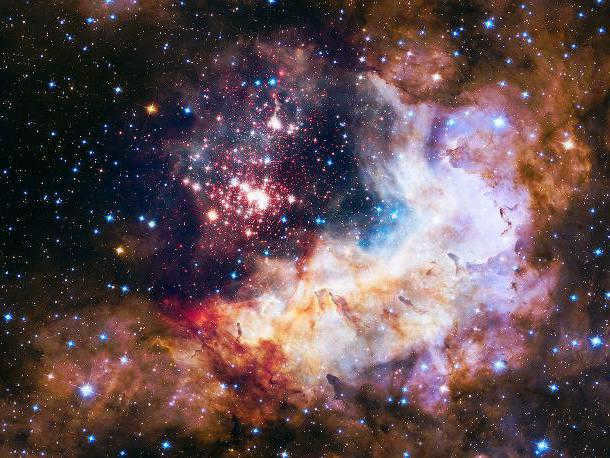
The concept of stellar collapse
The phenomenon of stellar collapse is regarded as the ultimate stage in the life cycle of stars that have a mass greater than three times that of the Sun. This metric is widely employed in the fields of astronomy and physics for the purpose of calculating the mass of other celestial bodies. Stellar collapse occurs when the powerful gravitational forces cause massive cosmic bodies to rapidly contract.
Stars with a mass exceeding three solar masses possess sufficient material to sustain ongoing thermonuclear reactions. However, once the fuel is depleted, the thermonuclear reaction ceases, rendering the stars mechanically unstable. As a result, they commence a rapid contraction towards their core at speeds exceeding the speed of sound.
Neutron stars
When stars undergo contraction, it results in the accumulation of internal pressure. If this pressure becomes strong enough to counteract gravitational collapse, a neutron star is formed.
A neutron star is characterized by a straightforward composition. It is comprised of a core, which is enveloped by a crust consisting of electrons and atomic nuclei. The crust is relatively thin, measuring approximately 1 km, in comparison to other celestial bodies.
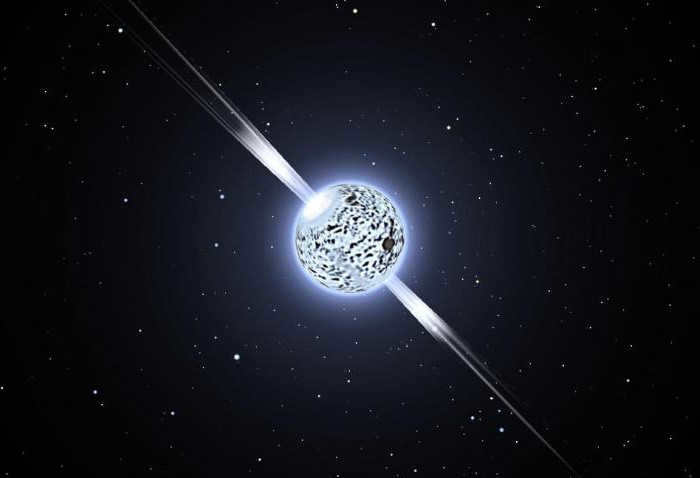
Neutron stars have a weight equivalent to that of the Sun, but their radius is much smaller, measuring no more than 20 km. Within these stars, atomic nuclei interact with one another, resulting in the formation of nuclear matter. The pressure generated by this matter prevents the neutron star from collapsing any further. These stars are known for their incredibly rapid rotation, with some completing hundreds of revolutions per second. The birth of a neutron star begins with a supernova explosion, which occurs as a result of the star’s gravitational collapse.
Supernovae
An occurrence known as a supernova flash is when a star experiences a sudden and dramatic increase in brightness, followed by a gradual fading. This marks the final phase of gravitational collapse, and the entire event is accompanied by the release of a substantial amount of energy.
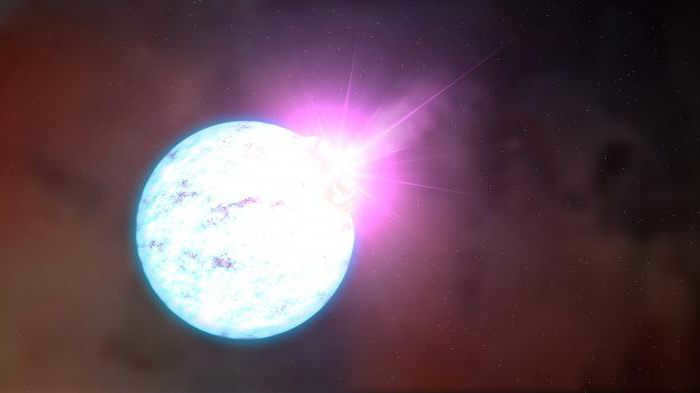
It should be acknowledged that the phenomenon can only be observed by Earth’s inhabitants after it has already occurred. The flash of light takes a considerable amount of time to reach our planet, posing challenges in determining the nature of supernovae.
The cooling of a neutron star
Following the gravitational compression that gives rise to a neutron star, its temperature becomes exceedingly high (significantly surpassing that of the Sun). However, the star gradually cools down through the process of neutrino cooling.
Within a span of a few minutes, the star’s temperature can decrease by a factor of 100. Over the course of the following century, this reduction occurs another 10 times. Once the star’s luminosity diminishes, the cooling process decelerates considerably.
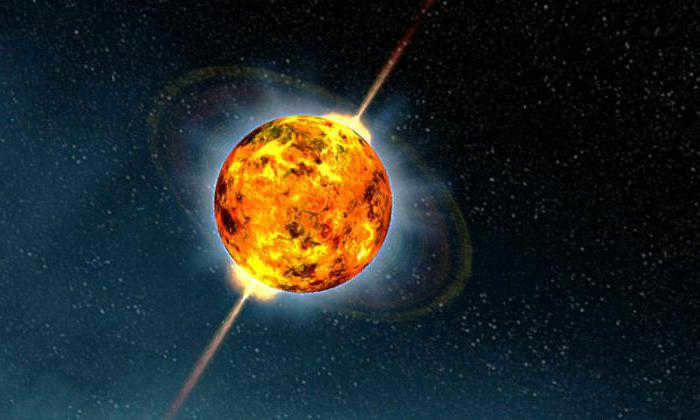
Oppenheimer-Volkov boundary
The Oppenheimer-Volkov boundary represents the maximum weight that a neutron star can reach before gravity is counteracted by the pressure of the neutron gas, preventing the star from collapsing into a black hole. Simultaneously, it also serves as a minimum threshold for the weight of black holes formed during the process of stellar evolution.
Because of several inaccuracies, it is challenging to ascertain the precise value of this parameter. Nonetheless, it is estimated to fall within the range of 2.5 to 3 solar masses. Currently, researchers assert that the most massive neutron star is J0348+0432, weighing over two solar masses. The lightest black hole, on the other hand, has a weight of 5-10 solar masses. Astrophysicists acknowledge that these findings are based on experimental data and only pertain to the neutron stars and black holes currently known, leaving open the possibility of more massive celestial bodies.
Dark Holes
A dark hole is one of the most fascinating occurrences discovered in outer space. It is an area of space-time where the gravitational pull is so strong that nothing can escape from it. Even objects that can travel at the speed of light (including particles of light itself) are incapable of leaving. Prior to 1967, dark holes were referred to as “frozen stars,” “collapsars,” and “collapsed stars.”
A dark hole has a counterpart. It is known as a bright hole. As we are aware, it is impossible to break free from a dark hole. As for bright holes, entering them is out of the question.
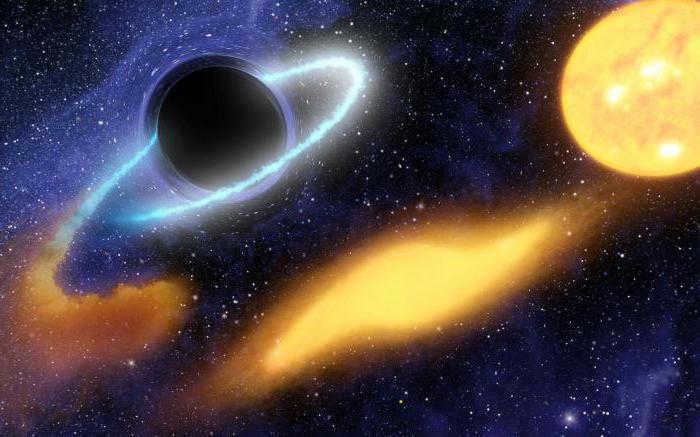
Aside from gravitational collapse, the formation of a black hole could also be attributed to a collapse at the core of a galaxy or proto-galactic center. Additionally, there is a hypothesis suggesting that black holes emerged as a consequence of the Big Bang, similar to our own planet. These black holes are referred to as primary by scientists.
Within our Galaxy, there exists one black hole that is believed, by astrophysicists, to have formed through the gravitational collapse of supermassive entities. Scientists propose that these black holes serve as the central cores of numerous galaxies.
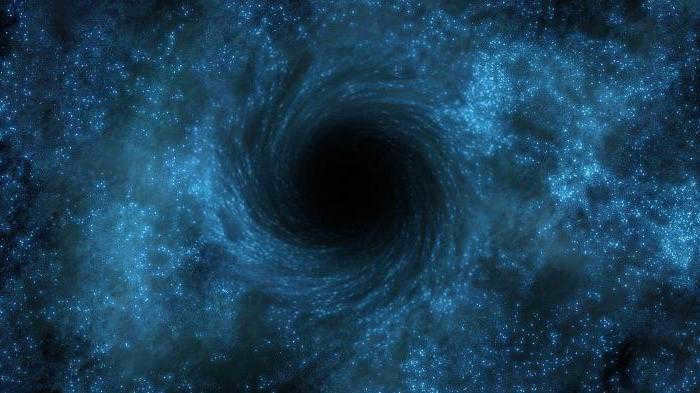

A group of astronomers from the United States has put forward a suggestion that the actual size of large black holes might be significantly underestimated. Their assumption is based on the observation that in order for stars to attain the velocity with which they move through the M87 galaxy, located 50 million light years away from Earth, the mass of the black hole at the center of the galaxy should be at least 6.5 billion times that of our Sun. Currently, it is believed that the largest black hole weighs around 3 billion solar masses, which is less than half of the estimated mass.
The Formation of Quantum Black Holes
According to scientific theory, black holes can potentially come into existence through nuclear reactions. These unique celestial bodies are known as quantum black holes, and they have a minimum size of 10 -18 meters and a minimum mass of 10 -5 grams.
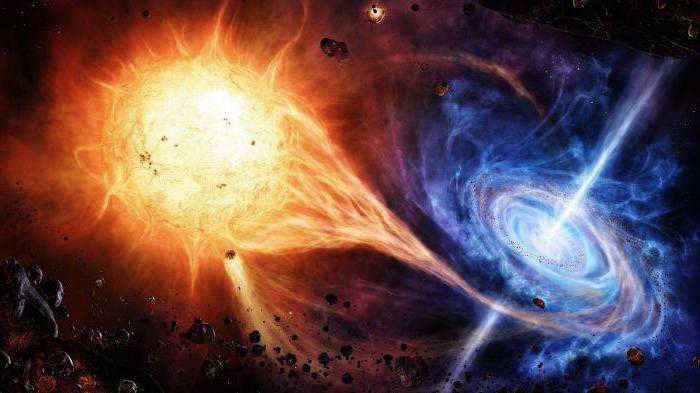
In order to create microscopic black holes, scientists constructed the Large Hadron Collider. The purpose of this project was not only to produce black holes, but also to simulate the Big Bang, thus enabling the recreation of the formation process of various celestial bodies, including our very own planet Earth. Unfortunately, the experiment was unsuccessful due to insufficient energy to generate black holes.
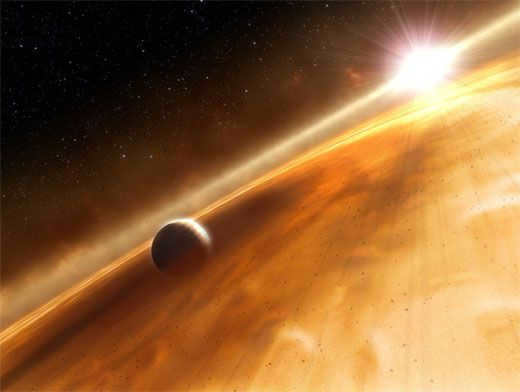
Alexander Chizhevsky, a renowned Russian scientist, had a groundbreaking theory that the activity of the sun could have a significant impact on the course of humanity. In his 1924 book “Physical Factors of the Historical Process”, Chizhevsky argued that increased solar activity correlated with an increase in cataclysmic events and their devastating consequences for mankind. Major wars, revolutions, and epidemics were found to occur during periods of heightened solar activity. However, these findings were based on estimations and comparisons, and the exact mechanism of the sun’s influence remained unclear. As a result, even in the 1970s, many scientists dismissed the idea that sunspot cycles could have any noticeable effects on life on Earth. This perspective was shared by Isaac Asimov in his widely-read book “The Choice of Catastrophes”.
On July 2, 2002, a tragic incident occurred in the airspace above Lake Constance in Germany. Two aircraft, a passenger Tu-154 and a cargo Boeing-757, collided, resulting in a devastating loss of life. Among the victims were 52 Russian teenagers who were on their way to enjoy a vacation. Interestingly, just one day prior to this tragic event, the SOHO space solar observatory, which is renowned as the primary solar observatory, detected a powerful explosion on the surface of the Sun. This was no ordinary occurrence, but rather a significant solar storm. It took a full 24 hours for the effects of this storm to reach Earth.
X Marks the Spot
Astronomers classify the most powerful and dangerous flares as X flares and assign them numerical coefficients of one or higher. In the past, these types of flares were rare and could be counted on one hand per cycle. However, the number of X flares has increased significantly. In July 2002 alone, there were four X flares: X3 on the 15th, X2 on the 18th, X4 on the 20th, and X5 on the 23rd. In the second half of 2003, a group of sunspots formed on the Sun that was unlike anything astronomers had ever seen before. This group was designated as 486 and one of its spots was larger than the planet Jupiter. Physicists were expecting surprises from this group, and they were not disappointed. On October 29th, 486 erupted in a massive explosion that was classified as X17. This type of explosion had only been recorded twice before, in 1989 and 2001. However, the Sun’s activity did not stop there and a few days later, it set a new record for luminosity.
On November 4, 2003, a flash of unprecedented power occurred, but its exact magnitude could not be determined as the orbital telescopes’ sensors were overwhelmed. Some telescopes recovered after 11 minutes, while others remained blinded for several days. Scientists initially classified the flash as X28, but many believed this was an underestimate. David Brodrick of the Australian National Observatory argued that the flare should be classified as X40 or even higher. Meanwhile, Mark Viering believed its power fell in the range of X34 to X48. To put this into perspective, an X40 explosion is equivalent to the energy released by a thousand billion tons of oil, which could sustain modern mankind for approximately 340,000 years.
Following a typical pattern, the Earth experienced the arrival of the solar wind after a day, resulting in the disruption of high-frequency radio communications, numerous electronic system failures, and the descent of the International Space Station by 7 kilometers. The Japanese probe “Nozomi” en route to Mars also encountered the solar wind a day later, causing it to malfunction and ultimately fail. Some scientists speculate that the landing systems of the European Beagle-2, which later crashed on Mars, may have been compromised by the solar wind.
Once people became aware of the potential risks associated with “solar hyperactivity,” they quickly sought to make predictions. However, in order to make accurate forecasts, it is necessary to have a general understanding of how the infamous sunspots and dangerous flares are formed. In 2004, Dr. Maousumi Dikpati’s research team from the U.S. National Center for Atmospheric Research (NCAR) developed the most precise model of the Sun. After testing this model in practical applications, they began making forecasts and, in early 2006, obtained a fascinating result.
According to Dr. Dikpati’s model, the current 24th cycle, which started in 2008 and reached its peak in 2012, will be at least 33% more intense than the previous cycle. It could even be as much as 150% more intense. However, the latter scenario is more probable than the former. Therefore, we should be prepared for an X60 flare-up.
A discussion with a specialist
The circumstance is being managed

Vladimir Obridko, the leader of the heliophysical laboratory at the Institute of Terrestrial Magnetism, Ionosphere and Radio Wave Propagation RAS (IZMIRAN, Troitsk), who holds a Doctorate in Physical and Mathematical Sciences.
– Vladimir Nukhimovich, could you please elaborate on the level of understanding that astrophysicists currently have regarding the processes occurring in stars?
– We have a good enough understanding of solar phenomena to be able to predict them. The standard model of the Sun has recently undergone rigorous testing and has passed with flying colors. Based on our current knowledge, the Sun is expected to maintain its current state for another 4-5 billion years. We have a solid grasp on solar activity and can make predictions with varying degrees of accuracy – such as the increase in activity every 11 years, the emergence of powerful active regions in a matter of weeks, flares and coronal mass ejections with up to 72 hours of advance notice, and the arrival of geoeffective flows to Earth within a few hours.
– Now, let’s discuss the reliability of our central star. Can we be completely certain that it won’t experience a catastrophic event similar to the Chernobyl reactor due to an internal malfunction? While reactors have self-regulation and control systems, what mechanisms “control” the Sun’s reactor?
– You can rest assured about that. The self-regulation system in the Sun is far more dependable compared to nuclear power plants.
– Some time ago, the entire online community was gripped with fear upon hearing the news that a certain Dutch astrophysicist, Piers Van der Meijer, believes that the Sun will undergo a “catastrophic explosion” in the coming years. They claim that the temperature at its core has already reached 27 million degrees Celsius, indicating the active formation of a new core.
– Firstly, there is no astrophysicist by that name in the Netherlands or anywhere else in the world. There are no scientific publications attributed to him. The media cited him in asserting that the Sun exhibits behavior similar to that of a new star a few years before it explodes. If only we knew how a new star behaves a few years prior to its explosion. We would certainly learn a great deal.
Regardless, there is nothing out of the ordinary happening in the Sun. And if the temperature of the core were to increase to such an extent, we would immediately notice it due to the significantly increased neutrino flux. However, that is not occurring.
– So, it’s a good thing that the Sun doesn’t explode. But what prevents it from, for example, increasing its power by only 10 percent? Or, on the contrary, reducing it by the same 10 percent. From what I understand, both scenarios could not only be dangerous for people, but almost fatal?
– I have already addressed this question. The reactions taking place in the center of the Sun do not allow for a quick change in its energy release. It takes billions of years. You can’t accelerate a 40-ton truck to 100 km/h in 10 seconds, a task easily accomplished by a small car. Miracles do not occur.
– How much impact do the processes occurring on the Sun have on our lives?
– I believe that the Sun has some degree of influence on every aspect of our lives. I won’t go into the obvious things, like the fact that the Sun provides us with light and heat, and without it, plants wouldn’t be able to grow (which means we wouldn’t have other sources of energy like oil, coal, etc.). It’s also essential for the existence of any atmosphere. More recently, we’ve discovered that the Sun plays a role in determining climate variations and also affects technical systems, human health, communication networks, high-voltage power lines, signaling systems on northern railway lines, and much more.
– The previous phase of solar activity witnessed a plethora of record-breaking flares. Nevertheless, numerous astrophysicists are predicting that the upcoming phase will be even more subdued. Let’s suppose that we were to experience a recurrence of the flare that occurred in November 2003, when all orbital telescopes were rendered temporarily blind, the International Space Station experienced a 7 km descent, the Japanese probe Nozomi malfunctioned, and a significant number of individuals suffered fatal strokes. The only difference this time would be that the flare would occur on the side of the solar disk facing us, rather than on the edge. Could this pose a potential threat to life, if not to humanity as a whole, then at least to our civilization?
– Let’s say we discovered an exceptionally strong solar flare (similar to the one that occurred in 1859, when telegraph stations caught fire due to induced currents). Do we have enough time to take any measures to reduce the potential damages?
– Actually, there is reason to believe that the estimates of the 1859 outbreak’s power are exaggerated. However, even such an outbreak is generally not a significant threat to humanity. The important thing is to work on minimizing the potential losses. By understanding the threat of outbreaks, we can firstly predict them and secondly mitigate their consequences. Let me provide two examples. You may be aware that a powerful flare in Canada once caused power grid shutdowns across the entire province of Quebec. While this event received a lot of attention, what was not widely reported is that the Canadian government took appropriate measures to address such issues in energy networks. They allocated funds, developed blocking systems, and as a result, no problems occurred during subsequent, much stronger flares and magnetic storms. You also mentioned the second example. Indeed, the powerful flares in November 2003 had undesirable effects. However, our institute’s prognostic center issued relevant recommendations, leading to the successful protection of many Russian satellites. Our prognostic center was also involved in calculating the timing for the descent from orbit of the MIR station. Without our forecast, the deorbiting process could have been delayed by one to two days, making it difficult to accurately bring it down at the intended location due to significant atmospheric disturbance.
– You have spent many years observing the Sun. Have you ever had the feeling that it is observing us as well? There are theories about the Earth being intelligent, so why not consider the possibility that the stars may also possess intelligence and personalities? Of course, this is not based on any concrete knowledge, theories, or assumptions, but rather on feelings and speculation. So, do you entertain such a notion, and if so, to what extent?
– Yes, I have been involved in the field of solar physics for 49 years. Naturally, the idea of an intelligent Sun seems more like a work of non-scientific fiction to me. However, it is still a fascinating concept! After all, are we truly capable of distinguishing between what is alive and what is not, or what is intelligent and what is not? I recommend reading Michael Creighton’s The Andromeda Strain, as it raises some intriguing thoughts on this matter.
Modeling
Modeling is the process of creating a representation or simulation of a real-world system or phenomenon. It involves the use of mathematical and statistical techniques to analyze and understand complex systems.
In the field of computer science, modeling is used to design and develop software systems. This involves creating a model of the desired system, which can be used to test and validate the system before it is implemented.
In the field of economics, modeling is used to understand and predict economic behavior. Economists create models to simulate economic systems and study the effects of different variables on the economy.
In the field of physics, modeling is used to simulate physical phenomena that are difficult or impossible to observe directly. This allows scientists to study and understand complex systems, such as the behavior of particles or the movement of fluids.
Overall, modeling is a powerful tool that allows scientists, engineers, and researchers to gain insight into complex systems and phenomena. It is an essential part of many fields and is used to solve a wide range of problems.

A game of sunspots
In 1908, George Hale, an astronomer from the United States, made an interesting discovery about sunspots. He found that these spots have a magnetic field that is 100 times stronger than the normal magnetic field of the Sun. This powerful magnetic field acts like a magnet and attracts charged particles from the Sun. Instead of escaping into space, these particles are pulled back into the Sun. This causes the solar wind, which is the flow of these particles, to become weaker when there are more sunspots. Eugene Parker, another American astronomer, coined the term “solar wind” in 1958 to describe this phenomenon. The Sun becomes “charged” for a while as it builds up energy, and eventually releases it in a powerful explosion. The strength of this explosion is directly related to the strength of the magnetic field of the sunspots.
If a single, accurately aimed solar flare with high power were to occur, it could potentially annihilate our electronic society. The intense radiation emitted by the sun would reach our planet within a mere 8 minutes following the flare, while the corpuscular solar wind would take approximately 24 hours to arrive. Such a surge in solar radiation has the potential to fatally harm the astronauts currently residing in the International Space Station (ISS) and render the space equipment inoperable. In fact, the solar panels of the station would be completely obliterated.
An intense ionization of the atmosphere will result in a total disruption of radio communication. Navigation systems would be rendered inoperable. The majority of aircraft in flight, deprived of communication and navigation capabilities, would simply collide. When particles from the solar wind collide with molecules in the air, they generate a luminous display known as the aurora borealis. The solar wind will cause the atmosphere to become denser. This will result in spacecraft decelerating, losing control, and crashing. One such powerful gust in 1979 caused the downfall of the American space station SkyLab, while another one brought down the ISS at an altitude of 7 km in 2003.
Various atmospheric phenomena are set in motion: thunderstorms, tempests, and hurricanes. These, in turn, will result in widespread flooding. Induced currents will cause the destruction of long metal objects such as power lines, pipelines, communication cables, and even simple railroad tracks. Consequently, all connected infrastructure, including transformer substations, power plants, pumping units, repeaters, and so on, will also be damaged.
Complex electronic equipment, including computers, will malfunction, potentially causing accidents at nuclear power plants and other high-tech facilities. There is evidence suggesting a correlation between Earth’s activity and solar activity. If this is indeed the case, a powerful solar flare should lead to an increase in volcanic activity and more frequent earthquakes.
During magnetic storms, millions of people who previously experienced only mild illness may now face a threefold increase in heart attacks and a twofold increase in strokes and angina attacks. However, if a powerful solar wind storm were to occur, these individuals would simply die. Unfortunately, there is no escape from such a storm as it engulfs the entire planet and lasts for several days. Even taking refuge in a bomb shelter or using metal grounding or magnetic correction bracelets will not provide protection. The only recommendations from scientists during this period are to rest more, avoid stress, and avoid additional physical exertion.
Supporters of numerology have long highlighted the intriguing, in their perspective, arrangement of the date for the anticipated apocalypse:
21 days, 12 months, 12 years of the 21st century
According to the principles of numerology, the number 21 (as well as 12) becomes 3 when its digits are added together (2+1=3).
So, we have a total of: day – 3, month – 3, year – 3, and century – 3. Four threes. And once again, this equals 12. Now we can add more fuel to the fire of numbers. Because, as we now understand, the current solar cycle is the 24th, and 24 is twice 12.

